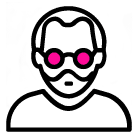Landing Page
What is a landing page, and how to design it?
The landing page is a key component to gaining new customers or leads. It allows the user to land on a page after completing an action or redirected by a CTA (call-to-action) of ads. For example, if you’re running a website and want visitors to sign up for the email newsletter or if you want to sell a product or sell a service or others, the landing page would be your best choice to complete a purchase or collect data.
Landing Page Design: 8 Steps that make a landing page.
Step 1. Write A Catchy Headline or Title
A catchy headline is critical as it will allow the audience to know straightforward on what you offer or what you do exactly. If your headline is good, it will compel the readers to take a look at your content. You can also use a value proposition that will attract the attention of your target audience. It would be best if you researched your competitors and what they are offering to their customers.
Landing Page Sample

Step 2. Hero Section
What is it you trying to tell or show your audience? If it’s a service you’re trying to provide, best is to your very own personal or yourself as the hero image, cause people to love visual impression rather than words. You might consider “horizontal” or parallax scrolling to create an illusion of depth. A horizontal scrolling page allows the user to scroll down (or up) across a picture to reveal additional content. Parallax scrolling is similar, but it involves more elements moving in tandem with the background.
Step 3. Social Verification or Proof
To show the audience that you are the real deal, certified product or professional service provider. A way to keep visitors on your site is to use a consistent design throughout your page. This will help you let the audience not bounce off your page and make the audience scroll through the page to see what else your page has to offer. Be consistent with your theme colours. For example, using the same colour scheme throughout your site makes people more comfortable about navigating your site, knowing that they’ll see something familiar wherever they go.
Step 4. Primary Content Points or Selling Points
Here is where you need to layout your key product or service selling point, where you can be as detailed as possible or keep it short and simple. Whether you are selling a product or service, let your viewer know what will make them successful. Show some examples of the problem faced and how your solution can effectively resolve this problem. Describe all the tools/libraries that are required to build the solution. How will you implement this in your project? Mention any difficulties in implementation? Discuss the skills required to implement the solution. Try to explain how it is different from other solutions.
Step 5. Benefits
Breaking it down to the audience, to tell them what are the benefits from your service or buying your product. Directly, the customer has to be aware of what you are offering. And what are the benefits of it?
Step 6. Customer Testimonials
This is the key ingredient of any landing page, showing off the real client reviews, feedback, or using your services or your products, which will gain the audience trust. Try not to use fabricated reviews, use genuine reviews, put down their names, pictures, or even use your service or products. People don’t like fake stuff.
Step 7. Social Sharing
Make It Viable for Visitors to Share the page, where you ask your visitors to share and like your page and services and products. This is a way that will help you reach out to more people and find their followers, too, getting more leads and possibilities of getting more customers. People nowadays don’t like to buy, and they like to decide if they are interested in buying. Failing to satisfy your prospects with valuable content is one of the most common mistakes you can make when attracting customers to your business.
Step 8. CTA (call-to-action)
By placing the CTA (call-to-action) towards the end of the page, you can avoid interrupting your message at the beginning. This way, you will lead the audience through your offer or service for a better conversion rate. Now, this is the part when you turn your leads to your customers. The key here is your offer or pricing. It is like a gateway to your customers. This is where you need to make sure that everything is aligned and makes sense to the customers. If they find what they need, then they will convert into customers.


